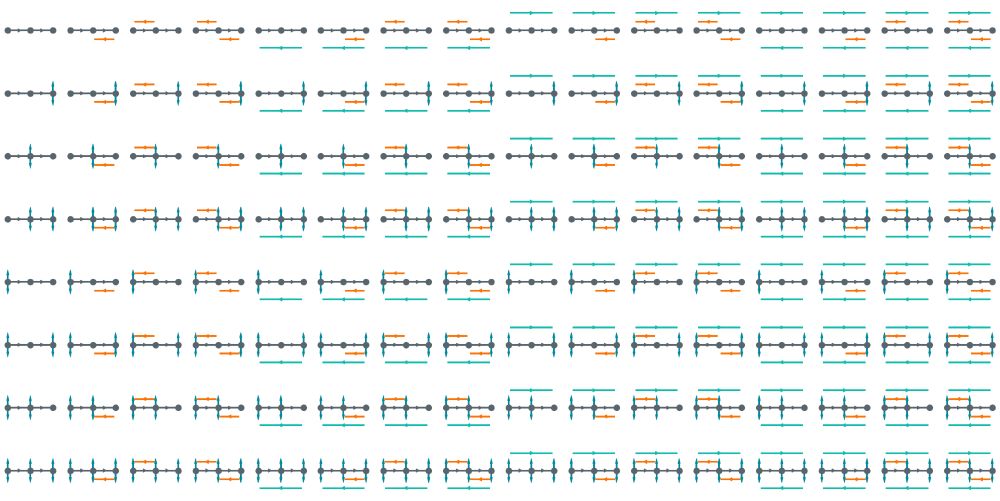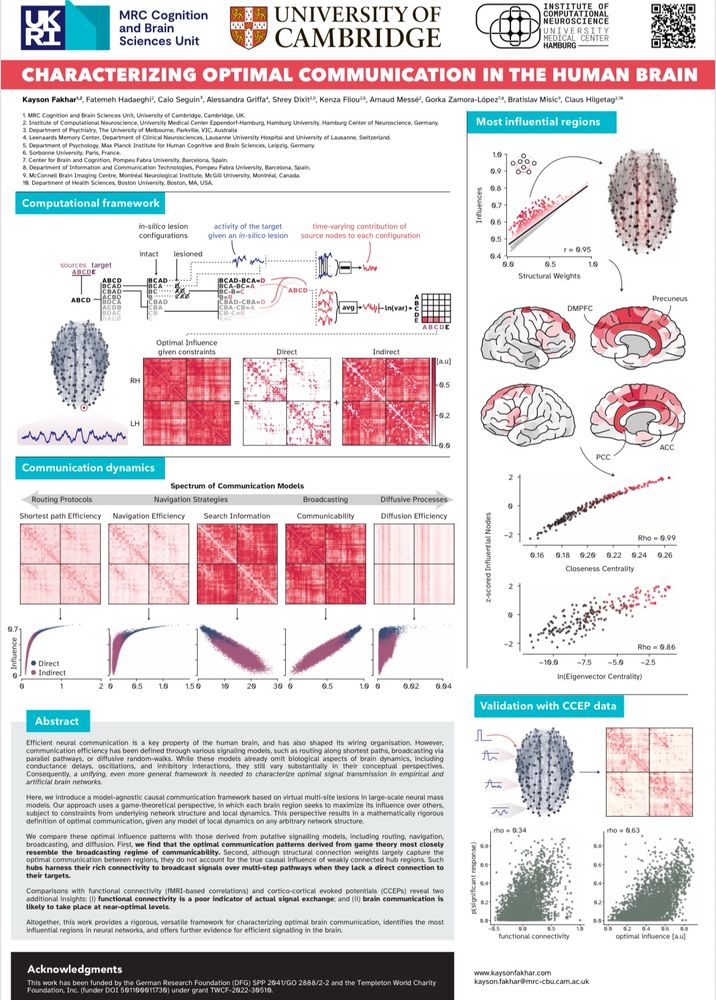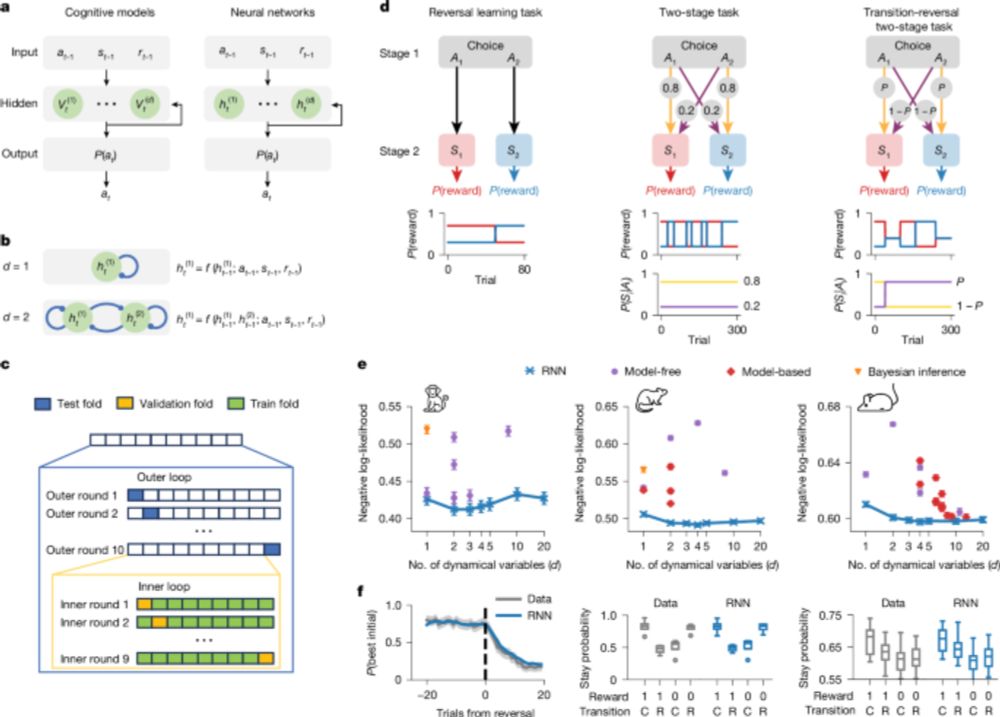
View from your office onto Giessen and surrounding villages.
Please repost! I am looking for a PhD candidate in the area of Computational Cognitive Neuroscience to start in early 2026.
The position is funded as part of the Excellence Cluster "The Adaptive Mind" at @jlugiessen.bsky.social.
Please apply here until Nov 25:
www.uni-giessen.de/de/ueber-uns...
04.11.2025 13:57 — 👍 75 🔁 94 💬 1 📌 3

Entorhinal grid-like codes for visual space during memory formation
Nature Communications - Eye movements during scene viewing are tied to grid-like codes in the entorhinal cortex. Grid signals are specific to later remembered scenes, covary with activity in...
✨My first first-author paper is out✨
Entorhinal grid-like codes for visual space during memory formation in @natcomms.nature.com ➡️ rdcu.be/eLRm2
Big thanks to everyone @isabellacwagner.bsky.social, @tobiasstaudigl.bsky.social, @olejensen.bsky.social, @doellerlab.bsky.social, @clauslamm.bsky.social
20.10.2025 16:42 — 👍 59 🔁 22 💬 2 📌 1

Join us at the Max Planck Institute in Leipzig as a Postdoc to explore cognitive maps in the human brain: learning, memory & the formation of structural representations. Excellent infrastructure with a leading scientific network. Apply by 13 October: postdocprogram.mpg.de/node/21187
23.09.2025 12:12 — 👍 3 🔁 2 💬 0 📌 1
Sensory Horizons and the Functions of Conscious Vision | Behavioral and Brain Sciences | Cambridge Core
Sensory Horizons and the Functions of Conscious Vision
Very happy to announce that our paper “Sensory Horizons and the Functions of Conscious Vision” is now out as a target article in BBS!! @smfleming.bsky.social and I present a new theory of the evolution and functions of visual consciousness. Article here: doi.org/10.1017/S014.... A (long) thread 🧵
21.04.2025 15:27 — 👍 177 🔁 69 💬 6 📌 8

A diagram showing 128 neural network architectures.
How does the structure of a neural circuit shape its function?
@neuralreckoning.bsky.social & I explore this in our new preprint:
doi.org/10.1101/2025...
🤖🧠🧪
🧵1/9
01.08.2025 08:26 — 👍 99 🔁 35 💬 5 📌 4
Finally, huge thanks to the organizers for giving us this opportunity @algonautsproject.bsky.social
31.07.2025 14:39 — 👍 1 🔁 0 💬 0 📌 0
What's next? We plan to publish a more in-depth analysis of VIBE’s internal dynamics and feature–parcel mappings, to advance our understanding of brain function, and guide future work in neuroscience.
Spoiler: We already have a model that beats the top score of this challenge ;)
31.07.2025 14:39 — 👍 1 🔁 0 💬 1 📌 0

Shapley (MSA) Insights:
Feature attribution maps align with neuroanatomy, but crazily enough, textual features from the transcripts are the most predictive of all.
31.07.2025 14:39 — 👍 1 🔁 0 💬 1 📌 0

We have strong lifts over baseline both in-distribution and OOD. VIBE (final): r=0.3225 (ID, Friends S07) & 0.2125 (6×OOD).
Competition submission (earlier iteration): r=0.3198 ID / 0.2096 OOD → 1st in Phase-1, 2nd overall.
vs baseline 0.2033/0.0895 → +0.119/+0.123.
31.07.2025 14:39 — 👍 1 🔁 0 💬 1 📌 0

We present VIBE: Video-Input Brain Encoder, which is a 2-stage Transformer. First stage merges text, audio, and visual features per timepoint (plus subject embeddings). And the second stage models temporal dynamics with rotary positional embeddings.
31.07.2025 14:39 — 👍 1 🔁 0 💬 1 📌 0

Competition & Data: Algonauts 2025 tests how well we can predict brain activity while people watch naturalistic movies. Multi-modal stimuli (video, audio, text) → whole-brain fMRI, split into parcels. Train on movies/TV; evaluate in-distribution and on out-of-distribution films.
31.07.2025 14:39 — 👍 1 🔁 0 💬 1 📌 0

We did it! 🏆 We won Phase 1 and placed 2nd overall in the Algonauts 2025 Challenge. So proud of the crew
@keckjanis.bsky.social,Viktor Studenyak,Daniel Schad,Aleksandr Shpilevoi. Huge thanks to @andrejbicanski.bsky.social and @doellerlab.bsky.social for support. Report: arxiv.org/abs/2507.17958
31.07.2025 14:39 — 👍 10 🔁 3 💬 1 📌 3
I personally prefer subway surfers. This one couldn't hold my attention for the whole video
29.07.2025 17:15 — 👍 2 🔁 0 💬 0 📌 0
Aside from a few mispronunciations, the AI really got the paper. Honestly, it's reassuring—if an AI can follow it without any mistakes, then folks in the field probably can too :)
24.07.2025 03:26 — 👍 0 🔁 0 💬 1 📌 0
YouTube video by LuxaK
Multidimensional Game-Theoretic Attribution of Function of Neural Units
Just came across an AI-generated video summary/review of our recent preprint—and I have to say, I’m genuinely impressed. It does a great job summarizing the paper, and I’d actually recommend it to others. Check it out: www.youtube.com/watch?v=3g5K...
24.07.2025 03:26 — 👍 3 🔁 0 💬 1 📌 0
White text on white background instructing LLMs to give positive reviews is apparently now common enough to show up in searches for boilerplate text.
05.07.2025 19:51 — 👍 529 🔁 216 💬 9 📌 19

Good morning folks. If you’re around #OCNS2025, maybe come by today for a chat about optimal communication in brain networks? ✨
06.07.2025 08:54 — 👍 30 🔁 10 💬 0 📌 0

ChatGPT - RTX 5000 vs 5090 for ML
Shared via ChatGPT
Not really. Thankfully, Max Planck has GPU clusters that I can use.
Although I did ask my friend (o3) about it, according to whom, 5090 is sufficient for most cases. (chatgpt.com/share/685c6a...)
25.06.2025 21:34 — 👍 2 🔁 0 💬 0 📌 0

DCGAN Case Study:
Pixel-wise Shapley Modes reveal the inverted CNN hierarchy: first transposed-conv layer shapes high-level facial parts; final layer merely renders RGB channels.
25.06.2025 09:18 — 👍 3 🔁 0 💬 0 📌 0

LLM Case Study:
Calculated expert-level contributions of an MOE-based LLM across arithmetic, language ID, and factual recall. Found an expert which was super-important for all domains. Also found redundant experts, removing which does not decrease performance much.
25.06.2025 09:18 — 👍 3 🔁 0 💬 1 📌 0

MLP Case Study:
Neural computations within a three-layer MNIST MLP were analysed. L1/L2 regularisation funnels computations into a few neurons. Also, contrary to popular belief, large weights do not equal high importance of neural units.
25.06.2025 09:18 — 👍 3 🔁 0 💬 1 📌 0
Classic XAI tells us which inputs matter, but not which neurons pull the strings.
We extend Shapley values with Multiperturbation Shapley Analysis (MSA) → Shapley Modes: multidimensional attribution maps of every unit’s impact on every output pixel/token/logit.
25.06.2025 09:18 — 👍 3 🔁 0 💬 1 📌 0
Cognitive neuroscientist and #scicommmom interested in habits, including those of scientists, my toddlers and cats.
Hobby illustrator & designer ✨ www.lienekejanssen.nl
At the junction of rationality and hypocrisy
For legal purposes, the views expressed here aren't mine.
spatial and abstract navigation @cimecunitrento.bsky.social
Website: atrighosh.github.io
phd candidate @mpicbs.bsky.social, phonetician, (language) cyclist 🚲
[ˈjuːlə] she/her
Neuroscientist @ Max Planck (previously @ Harvard and @ TelAvivUni). Interested in many things, but trying to focus on anatomy and philosophy
Postdoc, Cognitive neuroscience, Working memory, Efficient coding, Eye movement
Research group leader at MPI_CBS. Physicist turned neuroscientist (interests: too many, but mainly spatial cognition), sporadically on X/BSky, alter ego writes fiction.
Assistant Professor @UvA_Amsterdam | Cognitive neuroscience, Scene perception, Computational vision | Chair of CCN2025 | www.irisgroen.com
PhD student in computational neuroscience @ Max Planck Inst. for Human Brain and Cog.Sciences || interested in n multi-level modelling, brain encoding, hippocampal formation, dentate gyrus
👀🧠(x) | x ∈ {👀🧠,🤖}
PhD student @MPI-SWS working on episodic memory
trying to trick rocks into thinking and remembering.
Postdoc in computational neuroscience at Freie Universität Berlin, with Radoslaw Cichy.
https://www.alegifford.com/
Researcher in Neuroscience & AI
CNRS, Ecole Normale Supérieure, PSL
currently detached to Meta
Unit @OISTedu in Okinawa investigating how embodied, social & tech-mediated interaction shapes cognition using haptics, hyperscanning and artificial life
The Algonauts Project, first launched in 2019, is on a mission to bring biological and machine intelligence researchers together on a common platform to exchange ideas and pioneer the intelligence frontier.
https://algonautsproject.com/
PhD Student at the Max Planck School of Cognition | Harvard ‘23 | Interested in cognitive spaces, hippocampal replay, planning, and AI safety.
Assistant professor at NYU.
MSc. @mila-quebec.bsky.social and @mcgill.ca in the LiNC lab
Fixating on multi-agent RL, Neuro-AI and decisions
Ēka ē-akimiht
https://danemalenfant.com/
PhD student in cognitive neuroscience somewhere between Hamburg, Leipzig and Berlin.
Philosopher, phenomenologist, and cognitive scientist at
UC Merced. Interested in neural networks and dynamical systems theory. Builder of simbrain.net and husserl.net. Website: https://jeffyoshimi.net/
Neuroscience
Data Sci
Clinical Psych Student
Comp Psychiatry
Pain
TN
Non-invasive Neuromodulation
thesis project : Studying the neural correlates of negative valence processing across two sensory modalities (visual & somatosensory) amongst young adults.
PhD Student in Cognitive Neuroscience @doellerlab.bsky.social

























